Cobb County World Language Program courses are designed to assist the students' development of language and intercultural skills. Each course has set learning targets based on ACTFL's language proficiency standards and NCSSFL-ACTFL Can Do Statements. ACTFL standards goal areas are: Communication, Cultures, Connections, Comparisons, and Communities.
Communication
This is the main area of the standards and in which we based a great part of our course program. There are three modes within the communication standards, Interpersonal, Presentational, and Interpretive. Use the links below to learn more about the language domains and sublevels for each mode.
| MODES | |||||
| LEVELS | |||||
| Novice | 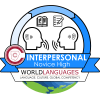 |
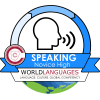 |
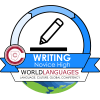 |
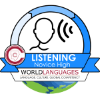 |
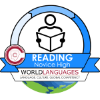 |
| Intermediate | 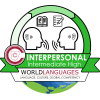 |
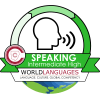 |
 |
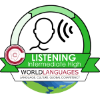 |
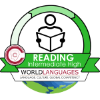 |
| Advanced | 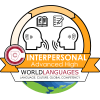 |
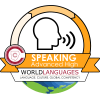 |
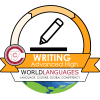 |
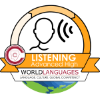 |
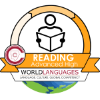 |
Culture
The study of culture and language is strongly interconnected. Students use the language to investigate and interact properly with the practices, perspectives, and products of the various cultures.
| LEVELS | |||
| Novice | 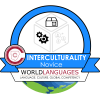 |
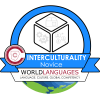 |
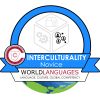 |
| Intermediate | 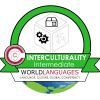 |
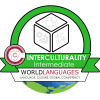 |
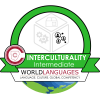 |
| Advanced | 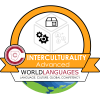 |
 |
 |
For more information and resources about language proficiency go to the American Council for Teachers of Foreign Languages (ACTFL) at: https://www.actfl.org/
The language proficiency targets indicate what students are expected to do with the language at the end of each course in terms of producing language (speaking and writing), understanding language (listening and reading), and interacting with others in the language. Proficiency targets for each language are based on the American Council on the Teaching of Foreign Languages (ACTFL) Proficiency Guidelines.
Click on each of the headings for details on the target skills for each level.
|
Level |
||||||
| K-5th Grade DLI - Bilingual |
Intermediate Mid |
Intermediate Mid |
Intermediate Mid |
Intermediate High |
Intermediate Mid |
Intermediate (-) |
|
6th Grade |
Novice Low |
Novice Low |
Novice Low |
Novice Low |
Novice Mid |
Novice |
|
7th Grade |
Novice Mid |
Novice Mid |
Novice Mid |
Novice Mid |
Novice High |
Novice |
|
Level I |
Novice High |
Novice High |
Novice High |
Novice High |
Intermediate Low |
Novice |
|
Level II |
Intermediate Low |
Intermediate Low |
Intermediate Low |
Intermediate Low |
Intermediate Mid (-) |
Intermediate (-) |
|
Level III |
Intermediate Mid (-) |
Intermediate Mid (-) |
Intermediate Mid (-) |
Intermediate Mid (-) |
Intermediate Mid |
Intermediate (-) |
|
Level IV |
Intermediate Mid |
Intermediate Mid |
Intermediate Mid |
Intermediate Mid |
Intermediate |
Intermediate |
|
Level V - VIII |
Intermediate High (-) to Advanced Low |
Intermediate High (-) to Advanced Low |
Intermediate High (-) to Advanced Low |
Intermediate High (-) to Advanced Low |
Intermediate High to Advanced Low |
Advanced |
|
Native Speakers I |
Intermediate High (-) |
Intermediate High (-) |
Intermediate Low |
Intermediate High |
Intermediate Low |
Intermediate (-) |
|
Native Speakers II |
Advanced Low (-) | Advanced Low (-) | Intermediate High (-) |
Advanced Low (-) | Intermediate High (-) |
Intermediate |
|
Native Speakers III |
Advanced Low | Advanced Low | Intermediate High |
Advanced Low | Intermediate High |
Advanced (-) |
Learn more about ACTFL's Language Proficiency Guidelines and the NCSSFL-ACTFL Global CAN-DO Benchmark Statements.
- Details
- Category: Language Proficiency
- Hits: 8893
The language proficiency targets indicate what students are expected to do with the language at the end of each course in terms of producing language (speaking and writing), understanding language (listening and reading), and interacting with others in the language. Proficiency targets for each language are based on the American Council on the Teaching of Foreign Languages (ACTFL) Proficiency Guidelines.
Click on each of the headings for details on the target skills for each level.
|
Level |
||||||
|
7th Grade |
Novice Mid |
Novice Mid |
Novice Mid |
Novice Mid |
Novice High |
Novice |
|
Level I |
Novice High |
Novice High |
Novice High |
Novice High |
Intermediate Low |
Novice |
|
Level II |
Intermediate Low |
Intermediate Low |
Intermediate Low |
Intermediate Low |
Intermediate Mid (-) |
Intermediate (-) |
|
Level III |
Intermediate Mid (-) |
Intermediate Mid (-) |
Intermediate Mid (-) |
Intermediate Mid (-) |
Intermediate Mid |
Intermediate (-) |
|
Level IV |
Intermediate Mid |
Intermediate Mid |
Intermediate Mid |
Intermediate Mid |
Intermediate |
Intermediate |
|
Level V - VIII |
Intermediate High (-) to Advanced Low |
Intermediate High (-) to Advanced Low |
Intermediate High (-) to Advanced Low |
Intermediate High (-) to Advanced Low |
Intermediate High to Advanced Low |
Advanced |
Learn more about ACTFL's Language Proficiency Guidelines and the NCSSFL-ACTFL Global CAN-DO Benchmark Statements.
- Details
- Category: Language Proficiency
- Hits: 5991
Communication
To share or exchange information, news, or ideas effectively in more than one language in order to function in a variety of situations and for multiple purposes.
 Interpretive Communication
Interpretive Communication
Learners understand, interpret, and analyze what is heard, read, or viewed on a variety of topics.
| Click the icons below to download the Interpretive Communication Self-Assessment Checklists. | Click the icons below to see the proficiency guidelines for each level. | ||
| Interpretive Listening |
Novice |
Intermediate | Advanced |
 |
 |
||
| Interpretive Reading | |||
 |
 |
 |
|
American Council of Teaching of Foreign Languages (ACTFL)
- Details
- Category: Language Proficiency
- Hits: 3782
Communication
To share or exchange information, news, or ideas effectively in more than one language in order to function in a variety of situations and for multiple purposes.
 Presentational Communication
Presentational Communication
Learners present information, concepts, and ideas to inform, explain, persuade, and narrate on a variety of topics using appropriate media and adapting to various audiences of listeners, readers, or viewers.
| Click the icons below to download the Presentational Communication Self-Assessment Checklists. | Click the icons below to see the proficiency guidelines for each level. | ||
| Presentational Speaking |
Novice |
Intermediate | Advanced |
 |
 |
||
| Presentational Writing | |||
 |
 |
 |
|
American Council of Teaching of Foreign Languages (ACTFL)
- Details
- Category: Language Proficiency
- Hits: 4173
Visual representations are a great tool to help students understand the progressive nature of language learning and the various levels they will reach in the process. The example below uses a road analogy with road markers to represent the various milestones (Inspired by Path to Proficiecy by Advanced Learning). Each marker's QR code will take students to the corresponding proficiency level Can-Do-Statement example self-assessment checklist.
Click HERE to download the image below in poster size.
Proficiency Journey Trail
- Details
- Category: Language Proficiency
- Hits: 8519
Communication
To share or exchange information, news, or ideas effectively in more than one language in order to function in a variety of situations and for multiple purposes.
 Interpersonal Communication
Interpersonal Communication
Learners interact and negotiate meaning in spoken, signed, or written conversations to share information, reactions, feelings, and opinions.
Click HERE to download the Interpersonal Communication Self-Assessment Checklist.
 |
Novice:
Expresses self in conversations on very familiar topics using a variety of words, phrases, simple sentences, and questions that have been highly practiced and memorized. |
 |
Intermediate: Expresses self and participates in conversations on familiar topics using sentences and series of sentences. Handles short social interactions in everyday situations by asking and answering a variety of questions. Can communicate about self, others, and everyday life. |
 |
Advanced: Expresses self fully to maintain conversations on familiar topics and new concrete social, academic, and work-related topics. Can communicate in paragraph- length conversation about events with detail and organization. Confidently handles situations with an unexpected complication. Shares point of view in discussions. |
American Council of Teaching of Foreign Languages (ACTFL)
- Details
- Category: Language Proficiency
- Hits: 3897
Culture
Interact with cultural competence and understanding. The study of culture and language is strongly interconnected. Students use the language to investigate and interact properly with the practices, perspectives, and products of the various cultures.
| LEVELS | |||
| Novice |  |
 |
 |
| Intermediate |  |
 |
 |
| Advanced |  |
 |
 |
- Details
- Category: Language Proficiency
- Hits: 2571
Click on the images below to learn more about language expectations and download the domain or level specific Student Self-Assessment Checklists documents.
| Performace Description |
Domain | Level |
 |
|
|
|
|
I can present information on academic and work topics. · I can present ideas about something I have learned, such as a historical event, a famous person, or a current environmental issue. · I can explain a series of steps needed to complete a task or experiment. · I can explain to someone who was absent what took place in class or on the job. · I can present my qualifications and goals for an academic program, training, or job. I can make a presentation on events, activities, and topics of particular interest. · I can present on something I learned from the media. · I can make a presentation about an interesting person. · I can summarize a personal, historical, or cultural event. · I can give a presentation about my interests, hobbies, lifestyle, or preferred activities. · I can make a presentation about the history or current status, of a school, organization, or company. · I can make a presentation about future plans. I can present my point of view and provide reasons to support it. · I can make a presentation on rules or policies such as cell phone use, dress code, or requirements for driving and explain my viewpoint. · I can share and justify my opinion on common issues such as allowances for children, curfews for teenagers, budget-related topics, etc. · I can explain my point of view on current event topics such as recycling, nutrition. · I can explain my point of view on current event topics such as recycling, nutrition and exercise, the food supply, conserving energy resources, extreme weather events, etc
|
- Details
- Category: Language Proficiency
- Hits: 1904
Click on the images below to learn more about language expectations and download the domain or level specific Student Self-Assessment Checklists documents.
| Performace Description |
Domain | Level |
 |
|
|
I can present information about myself and some other very familiar topics using single words or memorized phrases. |
|
I can recite words and phrases that I have learned. · I can count from 1-10. · I can say the date and the day of the week. · I can list the months and seasons
I can state the names of familiar people, places, and objects in pictures and posters using words or memorized phrases. · I can name famous landmarks and people. · I can name countries on a map. · I can list items I see every day.
I can introduce myself to a group. · I can state my name, age, and where I live. · I can give my phone number, home address, and email address.
I can recite short memorized phrases, parts of poems, and rhymes. · I can sing a short song. · I can recite a nursery rhyme. · I can recite a simple poem |
- Details
- Category: Language Proficiency
- Hits: 2135
Click on the images below to learn more about language expectations and download the domain or level specific Student Self-Assessment Checklists documents.
| Performace Description |
Domain | Level |
 |
|
|
I can present information on most familiar topics using a series of simple sentences. |
|
I can talk about people, activities, events, and experiences. · I can describe the physical appearance of a friend or family member. · I can describe another person’s personality. · I can describe a school or workplace. · I can describe a famous place. · I can describe a place I have visited or want to visit. · I can present my ideas about something I have learned.
I can express my needs and wants. · I can describe what I need for school or work. · I can talk about what I want or need to do each day.
I can present information on plans, instructions, and directions. · I can explain the rules of a game. · I can give multi-step instructions for preparing a recipe. · I can describe what my plans are for the weekend. · I can describe what my summer plans are. · I can describe holiday or vacation plans. · I can describe what is needed for a holiday or a celebration. · I can describe what I plan to do next in my life. I can present songs, short skits, or dramatic readings. · I can retell a children’s story. · I can present a proverb, poem, or nursery rhyme. · I can participate in a performance of a skit or a scene from a play.
I can express my preferences on topics of interest. · I can give a presentation about a movie or television show that I like. · I can give a presentation about a famous athlete, celebrity, or historical figure. · I can express my thoughts about a current event I have · learned about or researched |
- Details
- Category: Language Proficiency
- Hits: 1944
Click on the images below to learn more about language expectations and download the domain or level specific Student Self-Assessment Checklists documents.
| Performace Description |
Domain | Level |
 |
|
|
|
|
I can make a presentation about my personal and social experiences. · I can describe a childhood or past experience. · I can report on a social event that I attended. · I can make a presentation on something new I learned. · I can make a presentation about my plans for the future. I can make a presentation on smething I have learned or researched. · I can give a short presentation on a current event. · I can present about a topic from an academic subject, such as science, math, art, etc. · I can describe how to plan and carry out an event, such as a party or family reunion. · I can give a short presentation on a famous person, landmark, or cultural event. I can make a presentation about common interests and issues and state my viewpoint. · I can give a presentation about a favorite movie or song and tell why I like it. · I can give a presentation about a famous person or historical figure and tell why he/she is important. · I can share my reactions about a current event and explain why the event is in the news.
|
- Details
- Category: Language Proficiency
- Hits: 1899
Click on the images below to learn more about language expectations and download the domain or level specific Student Self-Assessment Checklists documents.
| Performace Description |
Domain | Level |
 |
|
|
I can present information about myself and some other very familiar topics using a variety of words, phrases, and memorized expressions. |
|
I can present information about myself and others using words and phrases. · I can say what I look like. · I can say what I am like. · I can say what someone looks like. · I can say what someone is like. I can express my likes and dislikes using words, phrases, and memorized expressions. · I can say which sports I like and don’t like. · I can list my favorite free-time activities and those I don’t like. · I can state my favorite foods and drinks and those I don’t like. I can present information about familiar items in my immediate environment. · I can talk about my house. · I can talk about my school or where I work. · I can talk about my room or office and what I have in it. · I can present basic information about my community, town/city, state, or country. I can talk about my daily activities using words, phrases, and memorized expressions. · I can list my classes and tell what time they start and end. · I can name activities and their times in my daily schedule. · I can talk about what I do on the weekends. I can present simple information about something I learned using words, phrases, and memorized expressions. · I can talk about holiday celebrations based on pictures or photos. · I can name the main cities on a map. · I can talk about animals, colors, foods, historical figures, or sports based on pictures or photos. |
- Details
- Category: Language Proficiency
- Hits: 2486
Click on the images below to learn more about language expectations and download the domain or level specific Student Self-Assessment Checklists documents.
| Performace Description |
Domain | Level |
 |
|
|
I can present basic information on familiar topics using language I have practiced using phrases and simple sentences. |
|
I can present information about my life using phrases and simple sentences. · I can describe my family and friends. · I can describe my school. · I can describe where I work and what I do I can tell about a familiar experience or event using phrases and simple sentences. · I can tell what I do in class or at work. · I can tell about what I do during the weekend. · I can tell about what happens after school or work. I can present basic information about a familiar person, place, or thing using phrases and simple sentences. · I can describe a useful website. · I can talk about my favorite musical group, actor, or author. · I can describe a landmark, vacation location, or a place I visit. · I can talk about a famous person from history. I can present information about others using phrases and simple sentences. · I can talk about others’ likes and dislikes. · I can talk about others’ free-time activities. · I can give basic biographical information about others. I can give basic instructions on how to make or do something using phrases and simple sentences. · I can tell how to prepare something simple to eat. · I can describe a simple routine, like getting lunch in the cafeteria. · I can give simple directions to a nearby location or to an online resource. I can present basic information about things I have learned using phrases and simple sentences. · I can describe a simple process like a science experiment. · I can present a topic from a lesson based on pictures or photos. · I can present information about something I learned in a class or at work · I can present information about something I learned in the community. |
- Details
- Category: Language Proficiency
- Hits: 1914
Click on the images below to learn more about language expectations and download the domain or level specific Student Self-Assessment Checklists documents.
| Performace Description |
Domain | Level |
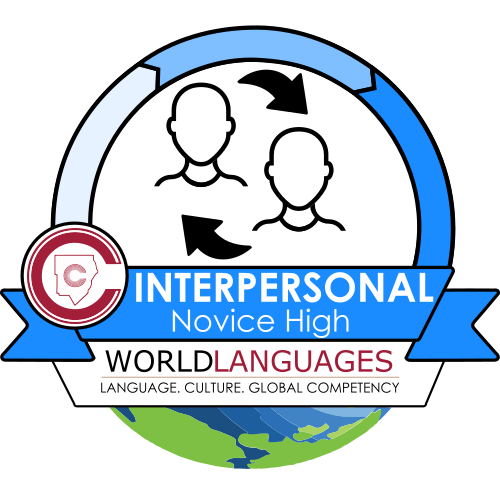 |
|
|
I can communicate on some very familiar topics using single words and phrases that I have practiced and memorized. |
|
I can greet my peers. · I can say hello and goodbye. I can introduce myself to someone. · I can tell someone my name. I can answer a few simple questions. · I can respond to yes/no questions. · I can answer an either/or question. · I can respond to who, what, when, where questions |
- Details
- Category: Language Proficiency
- Hits: 2163
Click on the images below to learn more about language expectations and download the domain or level specific Student Self-Assessment Checklists documents.
| Performace Description |
Domain | Level |
 |
|
|
I can communicate on very familiar topics using a variety of words and phrases that I have practiced and memorized. |
|
I can greet and leave people in a polite way. · I can say hello and goodbye to someone my age or younger. · I can say hello and goodbye to my teacher, professor, or supervisor. I can say hello and goodbye to an adult. · I can say hello and goodbye to a person I do not know. I can introduce myself and others. · I can introduce myself and provide basic personal information. · I can introduce someone else. I can respond to an introduction. I can answer a variety of simple questions. · I can answer questions about what I like and dislike. · I can answer questions about what I am doing and what I did. · I can answer questions about where I’m going or where I went. · I can answer questions about something I have learned. I can make some simple statements in a conversation. · I can tell someone what I am doing. · I can say where I went. I can say whom I am going to see. · I can express a positive reaction, such as “Great!” I can ask some simple questions. · I can ask who, what, when, where questions. · I can ask questions about something that I am learning. I can communicate basic information about myself and people I know. · I can say my name and ask someone’s name. · I can say or write something about the members of my family and ask about someone’s family. · I can say or write something about friends and classmates or co-workers. I can communicate some basic information about my everyday life. · I can give times, dates, and weather information. · I can talk about what I eat, learn, and do. · I can talk about places I know. I can ask and understand how much something costs. · I can tell someone the time and location of a community event. |
- Details
- Category: Language Proficiency
- Hits: 1872
Page 1 of 3















